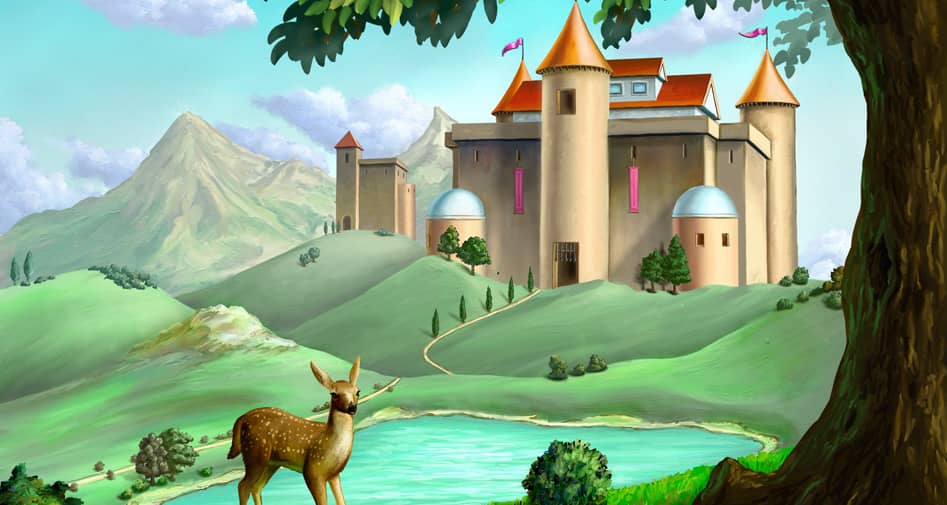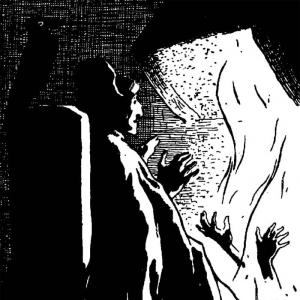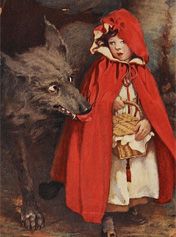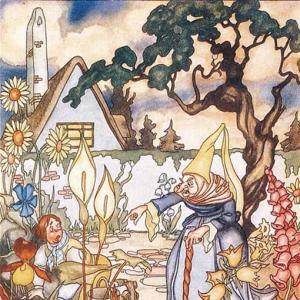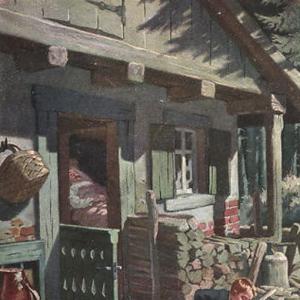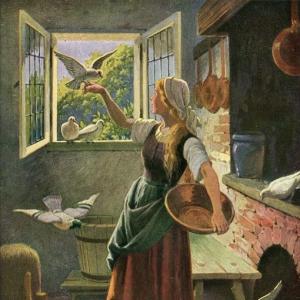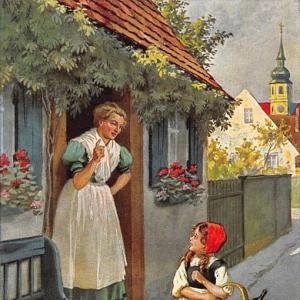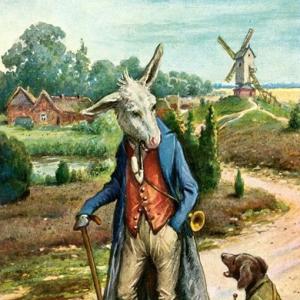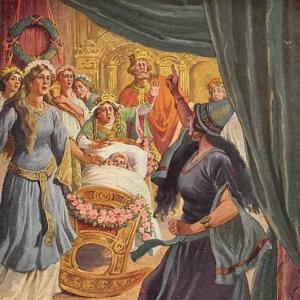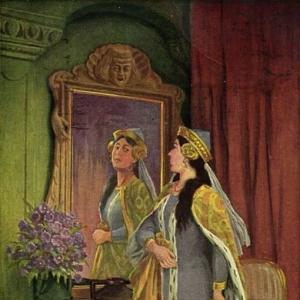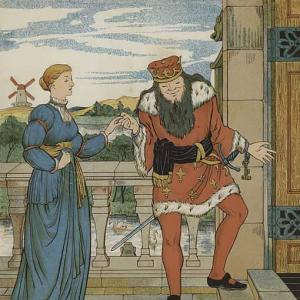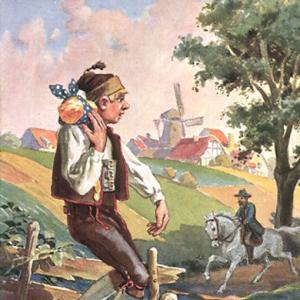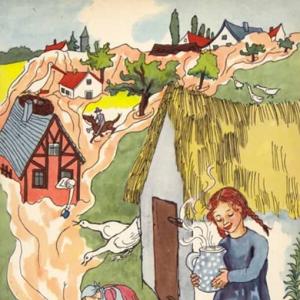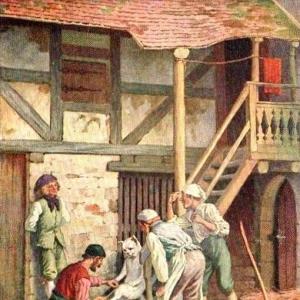Reading time for children: 5 min
Between the Baltic and the North Sea there lies an old swan’s nest, wherein swans are born and have been born that shall never die.
In olden times a flock of swans flew over the Alps to the green plains around Milan, where it was delightful to dwell. This flight of swans men called the Lombards. Another flock, with shining plumage and honest eyes, soared southward to Byzantium. The swans established themselves there close by the Emperor’s throne, and spread their wings over him as shields to protect him. They received the name of Varangians.
On the coast of France there sounded a cry of fear, for the blood-stained swans that came from the North with fire under their wings; and the people prayed, „Heaven deliver us from the wild Northmen.“
On the fresh sward of England stood the Danish swan by the open seashore, with the crown of three kingdoms on his head; and he stretched out his golden sceptre over the land.
The heathens on the Pomerian coast bent the knee, and the Danish swans came with the banner of the Cross and with the drawn sword.
„That was in the very old times,“ you say.
In later days two mighty swans have been seen to fly from the nest.
A light shone far through the air, far over the lands of the earth. The swan, with the strong beating of his wings, scattered the twilight mists, and the starry sky was seen, and it was as if it came nearer to the earth. That was the swan Tycho Brahe.
„Yes, then,“ you say. „But in our own days?“ We have seen swan after swan soar by in glorious flight. One let his pinions glide over the strings of the golden harp, and it resounded through the North. Norway’s mountains seemed to rise higher in the sunlight of former days. There was a rustling among the pine trees and the birches. The gods of the North, the heroes, and the noble women, showed themselves in the dark forest depths.
We have seen a swan beat with his wings upon the marble crag, so that it burst, and the forms of beauty imprisoned in the stone stepped out to the sunny day, and men in the lands round about lifted up their heads to behold these mighty forms.
We have seen a third swan spinning the thread of thought that is fastened from country to country round the world, so that the word may fly with lightning speed from land to land.
And our Lord loves the old swan’s nest between the Baltic and the North Sea. And when the mighty birds come soaring through the air to destroy it, even the callow young stand round in a circle on the margin of the nest, and though their breasts may be struck so that their blood flows, they bear it, and strike with their wings and their claws.
Centuries will pass by, swans will fly forth from the nest, men will see them and hear them in the world, before it shall be said in spirit and in truth, „This is the last swan, the last song from the swan’s nest.“
 Learn languages. Double-tap on a word.Learn languages in context with Childstories.org and Deepl.com.
Learn languages. Double-tap on a word.Learn languages in context with Childstories.org and Deepl.com.Backgrounds
Interpretations
Adaptions
Summary
Linguistics
„The Swan’s Nest“ is a lesser-known fairy tale written by the renowned Danish author Hans Christian Andersen. Born in 1805, Andersen is best known for his timeless collection of fairy tales that have captivated readers for generations. Some of his most famous stories include „The Little Mermaid,“ „The Ugly Duckling,“ „The Emperor’s New Clothes,“ and „The Snow Queen.“
Hans Christian Andersen’s stories often incorporate elements of folklore, mythology, and his own experiences, weaving them into enchanting and imaginative tales. His works have been translated into numerous languages and have had a significant impact on children’s literature and popular culture.
In „The Swan’s Nest,“ Andersen combines elements of European history, mythology, and allegorical storytelling to create a narrative that highlights the resilience, achievements, and interconnectedness of humanity. The swans in the story serve as symbols for various historical groups, events, or individuals, demonstrating the influence of these entities on the development and culture of different European regions.
The tale reflects Andersen’s deep appreciation for history, culture, and the power of storytelling. Although it may not be as widely recognized as some of his other works, „The Swan’s Nest“ offers valuable insights into the human experience and the enduring legacy of art, knowledge, and human perseverance.
„The Swan’s Nest“ by Hans Christian Andersen can be interpreted in various ways, reflecting themes such as history, culture, progress, and resilience. Here are some interpretations of the fairy tale:
History and culture: The swans in the story represent different groups of people or historical events that have shaped the regions they visit. The tale emphasizes the influence and impact of these groups on the development and culture of the respective regions, such as the Lombards in Milan, the Varangians in Byzantium, and the Danish swans in England and the Pomeranian coast.
Progress and knowledge: The story also highlights the achievements and contributions of individuals, like Tycho Brahe and the other swans who brought beauty, wisdom, and enlightenment to the world. This interpretation focuses on the importance of knowledge, art, and innovation in human history.
Resilience and perseverance: The swans defending their nest represent the strength and resilience of the people who inhabit the region between the Baltic and the North Sea. Despite facing challenges and threats, they persist and continue to contribute to the world, reflecting the human spirit’s ability to endure and thrive.
Unity and interconnectedness: The swans‘ actions often lead to connections between different regions and cultures, symbolizing the importance of unity and the interconnectedness of humanity. The third swan, who spins the thread of thought to connect the world, embodies this theme, demonstrating how ideas and communication can bridge cultural divides and bring people together.
In summary, „The Swan’s Nest“ offers a rich tapestry of interpretations, weaving together themes of history, culture, progress, resilience, unity, and interconnectedness to create a powerful narrative that highlights the indomitable spirit of humanity.
„The Swan’s Nest“ has inspired several adaptations in various forms of media. Here are some notable adaptations of the fairy tale:
„The Wild Swans“ (1977) – This animated film from the Soviet Union is based on „The Swan’s Nest“ and follows the story of a young princess who must rescue her brothers from a curse that has turned them into swans.
„The Swan Princess“ (1994) – This animated film from the United States is loosely based on „The Swan’s Nest“ and tells the story of a princess who is turned into a swan by an evil sorcerer and must rely on the love of a prince to break the curse.
„Swan Lake“ – This ballet, composed by Pyotr Ilyich Tchaikovsky, is loosely based on „The Swan’s Nest“ and tells the story of a prince who falls in love with a swan princess and must battle an evil sorcerer to break the curse that has turned her into a swan.
„The Ugly Duckling“ – This story, also written by Hans Christian Andersen, is often seen as a companion piece to „The Swan’s Nest“ as it deals with themes of transformation and acceptance. „The Ugly Duckling“ tells the story of a young duckling who is ridiculed for being different but eventually discovers that he is actually a swan.
„The Swan’s Nest“ (2014) – This short film from Denmark is a modern retelling of the fairy tale and tells the story of a young woman who discovers a swan’s nest on her rooftop and must decide whether to protect the swans or allow the construction of a new building to proceed.
Overall, „The Swan’s Nest“ has inspired a wide range of adaptations in various forms of media, demonstrating the enduring appeal of Andersen’s timeless fairy tale.
„The Swan’s Nest“ by Hans Christian Andersen is a fairy tale that explores the history and culture of the region between the Baltic and the North Sea. The story tells of swans, representing different groups of people, that fly to various parts of Europe, leaving their mark on history and influencing the development of these regions.
In ancient times, a flock of swans called the Lombards flew to the green plains around Milan, making it a delightful place to dwell. Another flock, known as the Varangians, settled near the Emperor’s throne in Byzantium, offering protection. Meanwhile, blood-stained swans from the North brought fear to the coast of France, leading the people to pray for deliverance from the wild Northmen.
The Danish swan came to England, donning a crown symbolizing three kingdoms and wielding a golden sceptre over the land. The Danish swans also arrived at the Pomeranian coast, converting the heathens and bringing the banner of the Cross and drawn swords.
In later times, the tale speaks of the swan Tycho Brahe, who illuminated the sky and made the starry heavens seem closer to Earth. In more recent times, other swans have emerged: one playing a golden harp, evoking the gods and heroes of the North, another breaking marble to reveal hidden beauty, and a third spinning threads of thought to connect the world.
Despite threats to the swan’s nest, the young swans defend their home fiercely. The story concludes by stating that centuries will pass and swans will continue to fly forth from the nest, making their mark on the world, before the last swan and the last song from the swan’s nest are ever seen or heard.
Hans Christian Andersen’s „The Swan’s Nest“ is a richly allegorical tale that uses swans as a metaphor for the cultural and intellectual contributions of the Scandinavian people to the world. A linguistic analysis of this fairy tale highlights several key aspects of Andersen’s narrative style and thematic concerns:
Metaphor and Symbolism: Throughout the narrative, swans symbolize the people of the Scandinavian countries and their intellectual and cultural legacy. The swan is a common symbol in literature, often associated with beauty, grace, and transformation. Andersen extends this symbolism to represent the enduring influence and achievements of his homeland.
Imagery: Andersen’s use of vivid imagery captures the majestic flight of the swans and their noble characteristics. Descriptive passages such as „shining plumage and honest eyes“ and „stretched out his golden sceptre over the land“ create a sense of grandeur and nobility. The imagery not only enhances the narrative but also imbues the swans—and by extension, the people they represent—with a sense of purpose and dignity.
Narrative Structure: The tale is structured as a historical allegory, weaving together different time periods and events. Andersen references historical migrations and explorations of Scandinavian peoples, such as the Lombards and the Varangians, to highlight their contributions to European culture. This structure serves to celebrate Scandinavian heritage and its impact on the wider world.
Personification: Andersen personifies the swans with human attributes and actions, such as soaring, protecting, playing the harp, and engaging in intellectual endeavors. This personification allows readers to draw parallels between the swans and the historical figures and achievements that he is alluding to.
Themes of Legacy and Perseverance: A central theme in the tale is the enduring legacy and perseverance of the Scandinavian people. Andersen’s narrative suggests that while individual swans may come and go, the swan’s nest—representing the cultural and intellectual heart of Scandinavia—remains, nurturing new generations who will continue to make their mark on the world.
Mythological and Historical Allusions: Andersen subtly interweaves elements of mythology and history. By referring to figures like the gods of the North and historical incidents such as the arrival of Norsemen on the French coast, he enriches the narrative with a sense of timelessness and continuity.
Religious Undertones: There are underlying religious references, such as the “banner of the Cross” and divine protection over the swan’s nest, indicating Andersen’s view of a divine favor or destiny that guides and protects the Scandinavian people through the ages.
In summary, „The Swan’s Nest“ is a celebration of Nordic achievement and resilience. Andersen’s use of metaphorical language, combined with rich imagery and personification, crafts a narrative that honors the past while looking forward to future contributions from Scandinavia to the world.
Information for scientific analysis
Fairy tale statistics | Value |
|---|---|
| Translations | DE, EN, DA, ES, NL |
| Readability Index by Björnsson | 31 |
| Flesch-Reading-Ease Index | 83.3 |
| Flesch–Kincaid Grade-Level | 6.7 |
| Gunning Fog Index | 8.8 |
| Coleman–Liau Index | 8.8 |
| SMOG Index | 7.1 |
| Automated Readability Index | 8.5 |
| Character Count | 2.874 |
| Letter Count | 2.225 |
| Sentence Count | 26 |
| Word Count | 533 |
| Average Words per Sentence | 20,50 |
| Words with more than 6 letters | 56 |
| Percentage of long words | 10.5% |
| Number of Syllables | 647 |
| Average Syllables per Word | 1,21 |
| Words with three Syllables | 12 |
| Percentage Words with three Syllables | 2.3% |
